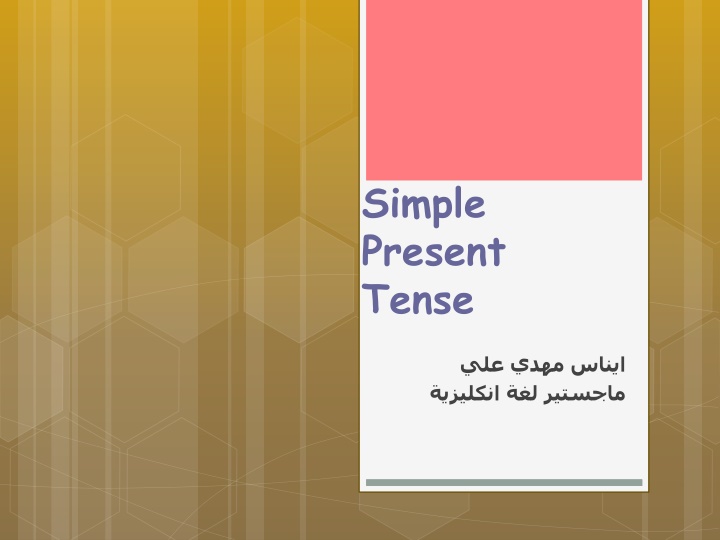
Simple Present Tense for English Learners
Learn about the Simple Present Tense in English grammar, including its usage for repeated actions, affirmative sentences, subject pronouns, and verb conjugation rules with examples. Enhance your understanding of the present simple tense with clear explanations and visuals.
Download Presentation

Please find below an Image/Link to download the presentation.
The content on the website is provided AS IS for your information and personal use only. It may not be sold, licensed, or shared on other websites without obtaining consent from the author. If you encounter any issues during the download, it is possible that the publisher has removed the file from their server.
You are allowed to download the files provided on this website for personal or commercial use, subject to the condition that they are used lawfully. All files are the property of their respective owners.
The content on the website is provided AS IS for your information and personal use only. It may not be sold, licensed, or shared on other websites without obtaining consent from the author.
E N D
Presentation Transcript
Simple Present Tense
Simple Present Tense The present simple is the tense we use to talk about a specific action or event that happens repeatedly That is, it happened in the past, in the present, and in the future. EX : (the sun rises in the east) .
affirmative in the simple present tense The sentence in the present simple is divided into two types based on the subject singular Plural
The subject and subject pronouns are divided into two groups: First: third-person pronouns They are the pronouns that express the singular subject (He, she and It), and the form of the sentences is as follows:
Examples : He gets up at 7:00 o clock every day. She always reads Quran. The Sun rises in the east and sets in the west. Ahmad does homework. Samira brushes her teeth every night.
Simple Present Tense When do we put to the verb (es) or (ies) in the present simple tense
1- add (es) we add (es) if the verb ends in the following letters (s, ch, x, o, sh, z): Examples: brush watch brushes watches
Example: mix go goes buzz mixes buzzes
2- Add (ies) We add (ies) to the verb in the following case: If the verb ends in a consonant + y, we drop the y and add ies (consonant+ y) study studies party parties fly flies
Second: plural The plural if it is a noun indicating a plural such as boys or children or the following pronouns (They, We, You and I) we put the first conjugation of the verb without adding anything. Subject + verb + object
Examples: I play football every weekend They often do homework afternoon We listen to our National Anthem every morning
Negation in the simple present tense We use to negate the sentence in the simple present (do) and (does). We put (do+ not) with the plural, and we put (does+ not) with the singular (third-person pronouns)..
Examples: He does not play in the class We do not go to bed late They do not eat pork Note: In the negative and the question, we put the singular as it is, without adding (s) or (es).
The question is in the present simple tense We put (do) or (does) at the beginning of the sentence, then the subject, then the verb. Do or Does + subject + verb + object ? Do you study English? Answer:.Yes, I do (No, I don t. (don t = do not
Examples: Does she speak Arabic ? No, she doesn t. (doesn t = does not) DoesAhmad like a football match? Note: In the negative and the question, we put the singular as it is, without adding (s) or (es).






















